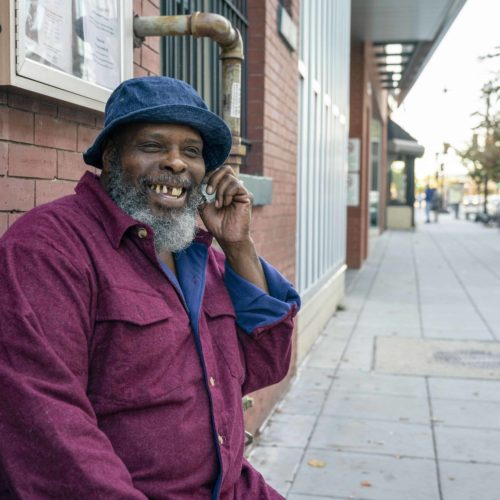This story was published in partnership with USA Today.
Introduction
Leonard Edwards keeps a smart phone in his front pants pocket. He uses his limited minutes to schedule medical appointments and order prescriptions from the pharmacy for the pain from his osteoarthritis, a degenerative disease that has eroded the cartilage and bone in his hips.
But Edwards’ access to that cellphone may be at risk. He got it through Lifeline, which is among the federal assistance programs being targeted by the Trump administration. Enrollment nationwide has dropped by 2.3 million people — about 21 percent — since 2017.
Edwards lives in Washington, D.C, where nearly half of Lifeline users have lost their subsidized phones in the last two years — the biggest decline in the country. Edwards worries about what would happen in an emergency like one he dealt with in 2016. With his legs paralyzed by pain, he used the last 10 minutes on his phone plan to call for help.
“Without Lifeline, I don’t know where I would have been,” said Edwards, 58. “For me, that was a game-changer.”
Edwards, who after two hip surgeries is disabled and unable to work, is one of the 9 million Americans with access to a phone or data plan thanks to Lifeline.
The Federal Communications Commission began subsidizing home phone lines in 1985 to provide “the opportunities and security that phone service brings” to people who cannot afford it, according to the FCC’s website. The program started including cellphone plans in 2005.
Currently, subscribers receive $9.25 per month to put toward a discounted cellphone plan designed by provider companies. For Edwards, that means a cap of 250 voice minutes and 2 GB of mobile data.
Lifeline enrollment peaked at 17.6 million subscribers in 2012 when the program had a budget of $2.1 billion, nearly twice its present size.
Lifeline enrollment
Source: USAC filings with the FCC
It long has been marked by allegations of fraud perpetrated by service providers with a financial incentive, who collect a subsidy for every subscriber they enrolled. A 2017 U.S. Government Accountability Office report could not prove eligibility for nearly a third of the Lifeline subscribers it reviewed.
In 2012, reforms placed stricter controls on Lifeline funds and created a subscriber database to reduce duplicate accounts. These reforms, along with an improving economy, led to a decline in Lifeline subscribers.
Over the past two years, the FCC has been introducing a computer system that, by automatically confirming eligibility for Lifeline subscribers and taking the review process out of the hands of providers, was supposed to further prevent fraud. A year after the 2018 rollout, however, the screening system isn’t working as planned.
The computer system, called the National Eligibility Verifier, lacks access to key federal and state databases needed to check eligibility. Enrollment is down in several states where the verifier is fully launched. In Mississippi and Wyoming, for example, it has dropped by more than one third since the rollout began.
In an emailed statement, FCC spokesman Mark Wigfield said the steep drop in subscribers shows the crackdown is working.
“Given the high rate of improper payments in the Lifeline program,” Wigfield wrote, “it makes sense that subscribership in the program is decreasing as more anti-fraud efforts take effect.”
| State | Percent change in enrollment since 2018 | Verifier launch stage |
| Virgin Islands | -94 | Hard |
| District of Columbia | -49 | Hard |
| Mississippi | -37 | Hard |
| Wyoming | -36 | Hard |
| Puerto Rico | -33 | Soft |
| Delaware | -32 | Hard |
| Utah | -29 | Hard |
| Vermont | -29 | Soft |
| New Hampshire | -28 | Hard |
| Florida | -26 | Not launched |
| Massachusetts | -26 | Soft |
| Nebraska | -25 | Soft |
| Arizona | -24 | Soft |
| Texas | -23 | Not launched |
| Missouri | -21 | Hard |
| Kansas | -20 | Soft |
But Lifeline supporters say the Trump FCC’s subscriber purge is less about rooting out malfeasance than about ending the program.
Another series of reforms is slated for December that providers and advocates say would make it nearly impossible for many cellphone companies to stay in the program. The companies say the changes — increasing the amount of mobile data that must be offered and phasing out support for cellphone call minutes — will make it too costly for providers with the subsidy of less than $10 a month.
“In my mind, it’s very clear that what they are trying to do is kill the program,” said Crystal Rhoades, a Democratic member of the Nebraska Public Service Commission. “This is a deliberate and disgusting assault on people who live in poverty.”
Rhodes knows the benefits of the program personally. Lifeline helped her pay for a landline in the 1990s, when she was a college student and young mother. Access to phone service she couldn’t otherwise afford, she said, helped her register for classes and arrange for babysitters.
Verifier problems
The verification system was approved by the FCC in 2016, when Democrats controlled the commission. It was supposed to ensure that Lifeline applicants met income eligibility requirements or were enrolled in a qualifying federal assistance program such as Medicaid, Supplemental Security Income or the Supplemental Nutrition Assistance Program (SNAP), formerly known as food stamps.
If the system confirmed a Lifeline applicant’s enrollment in one of these programs, in theory it would automatically approve the person for a phone plan. It also was supposed to reduce fraud by taking over the verification process from service providers.
The FCC began introducing the verifier incrementally starting in 2018. States use the verifier first in a soft launch phase, when potential Lifeline subscribers can prove eligibility through the verifier as well as legacy enrollment systems, and then a hard launch phase, when all verification must come through the national verifier.
Results of the rollout have varied from state to state. The electronic link to state benefit databases is spotty, including to those that track enrollment in SNAP and Supplemental Security Income.
Gaps in information from states and territories where benefit databases are not fully connected to the Lifeline system exclude eligible people from the program, service providers and advocates for low-income consumers say. Participation in the Virgin Islands has plummeted 94 percent since the verifier’s launch, according to a Center for Public Integrity analysis of FCC data.
In South Dakota, Chris Nelson, the Public Utilities Commission’s vice chairman and a Republican, supports the idea of controlling Lifeline costs. But the system doesn’t have access to his state’s social services databases, so he is concerned it will cause deserving Lifeline applicants to be turned away.
Nelson urged the National Association of Regulatory Utility Commissioners, which represents state public service commissioners, to pass a resolution asking the FCC to halt the verifier rollout until the agency connects it to federal and state databases. The association issued the resolution in July stating that data show “many potentially and apparently eligible Lifeline subscribers” have been cut from the program, with enrollment plummeting in the six states where the verifier initially launched.
The FCC connected the verifier to the federal Medicaid database in September, which the agency says will solve many of the connection issues. But the verifier still has not connected to many of the state databases that would help check eligibility for a majority of subscribers.
In planning documents for the national rollout, the FCC says it anticipates connection problems — technical or data privacy issues — in five states: Alabama, Connecticut, Florida, Louisiana and New York.
Public utilities regulators from New York, Vermont, Georgia, Connecticut and Nebraska asked for a delay but were denied on Oct. 22, the day before their hard launch was scheduled.
‘Fiscal nightmare’
Cellphones became part of Lifeline for the first time when George W. Bush was still president. A year later, the program became known — pejoratively in some circles — as the “Obama Phone.”
The moniker also became a symbol of the ideological divide between progressives who embraced the program and conservatives who dismissed it as wasteful.
The FCC expanded the Lifeline data plan in 2016 to include broadband internet access. In the same reform order, the commission also created the national verifier and offered incentives for providers to include high-speed internet access in their Lifeline packages.
At the time, current Trump-appointed FCC Chairman Ajit Pai was a committee member and a frequent Lifeline critic. Pai, a former Verizon and Justice Department lawyer, issued a dissenting opinion calling Lifeline a “fiscal nightmare.”
Today, Pai says combatting fraud is the sole motivation for the Trump administration’s reforms.
“Our goal is to make sure the Lifeline program for once and for all, focuses on consumers, not on the unscrupulous companies that for too long have bilked the FCC,” Pai told the Senate Commerce, Science and Transportation committee during an August 2018 hearing.
But consumer advocates see the changes in Lifeline as part of a broader campaign to cut back on resources for poor people. The Trump administration has already targeted other federal assistance programs such as Medicaid and food stamps for budget cuts and reforms that would limit access.
“We’ve unfortunately seen the Trump FCC engage in very unhelpful and unconstructive rhetoric and behavior that has really destabilized the program,” said Cheryl Leanza, a policy advisor for the United Church of Christ’s Media Justice Ministry, which works to make media and technology more accessible.
The District of Columbia illustrates the data gaps that threaten eligible Lifeline subscribers’ phone access. The screening system automatically recognizes public housing residents and those on Medicaid as eligible for Lifeline. Others will have to apply manually.
Every Lifeline customer needs to reverify for the program once the national verifier launches in their area, which happened in Washington on May 7. In the past, Edwards has had to recertify his eligibility for Lifeline every year in September. When he tried this year, however, a customer service representative told him he didn’t need to reapply at this time.

He said such confusion is business as usual for Lifeline users.
Last year, Edwards estimates he spent almost 20 minutes on the phone talking through the process — a big chunk of the monthly 250 minutes he carefully rations. Then, he said, he had to go through the same recertification process three times in a six-week period.
“They always make you jump through hoops,” Edwards said. “It’s getting to be more of a hassle than anything.”
Losing access to his cellphone would mean returning to a life of isolation. Before Edwards had a phone, when his family in New York and North Carolina hadn’t heard from him in months, they assumed he was either dead or in jail.
“I was an island,” he said. “Without [Lifeline], I would be that island again.”



Join the conversation
Show Comments